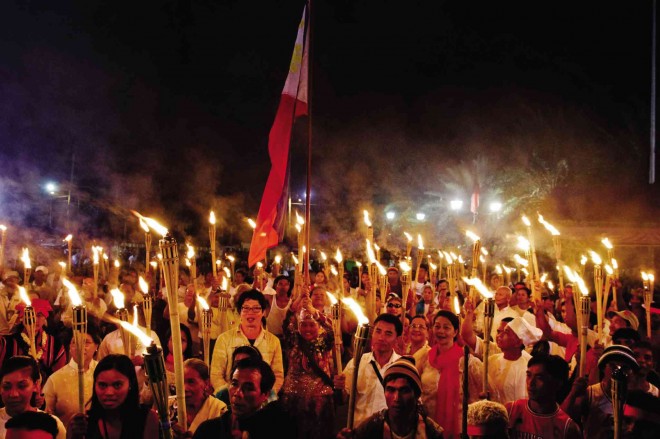Rizalista groups unite for the youth

APO Reyna Yolanda Liban Manalo, founder of Celyo Rizal, raises the Philippine flag amid torches held by leaders and members of various groups of Rizalistas, together with local government officials, during a ceremony held at the foot of the 7-meter-tall Rizal statue in Calamba City, Laguna, hours before midnight on June 18. The province celebrated the national hero’s 154th birth anniversary. CHRIS QUINTANA/CONTRIBUTOR
Wearing a purple and gold colored gown, Reyna Yolanda Liban Manalo stood like a queen, sans a crown, before the statue of Dr. Jose Rizal.
It was a few hours before midnight when Manalo, in her 60s, began to stretch out her hands, bowed down her head, and let out a song-like wail at the foot of the national hero’s 7-meter-tall brass statue.
The audience fell into silence as Manalo, much like a priestess, performed the “ritual for unity” under a damp, starless night. It was then that 154 torches, symbolizing the 154th birth anniversary of Rizal, were lit and the bearers formed what could be gleaned from the top as an odd spiral of fire.
“It was the first time that something like this happened,” said Peter Capitan, the Calamba information officer.
He was referring to the “pagbubuklod,”or the rare assembly of various Rizalista groups held on the eve of June 19, the hero’s birthdate.
Article continues after this advertisementRizal’s face
Article continues after this advertisement“Rizalista” is a collective term for groups who associate themselves with Rizal.
In the Philippines, there are over 200 groups, many of them based in Rizal’s birthplace, Calamba City. Some of them are nongovernment organizations, which strive to emulate Rizal’s life and works through civic programs; while others go as far as having a deep spiritual devotion to the national hero.
Manalo, for instance, leads the group called the Celyo Rizal Inc. They traveled far, from Cagayan Valley, on board two private buses in time for the pagbubuklod.
“We believe in him (Rizal) as the third to have come after Moses and after Christ,” said Jesus Bongais, 75.
Bongais, a member of Celyo Rizal, came in dressed like a Katipunero but all in white, “symbolizing purity.”
Bongais said he was 48 when he first started hearing the voice of Rizal. The voice, which he gestured had whispered to his right ear, told him to find the “kingdom.” Bongais left his wife and three children and for years traveled from Laguna, to Palawan, Sorsogon, and finally to Cagayan where he came across Manalo, “whose face was both of Christ and of Rizal,” he said.
The pagbubuklod served as the highlight of the Fiesta Rizalista, a two-day event that started on June 18 and was organized by the city government. Throughout the day, trade booths were put up in the city’s plaza where the tallest Rizal statue in the Philippines stands.
Aside from Celyo Rizal, about 20 other Rizalista groups joined the assembly. Among them were the better known organizations Iglesia Watawat ng Lahi, Cadena de Amor and the Universal Rizalista Brotherhood Association Inc. There were also the nongovernment organizations, such as the Knights of Rizal and Tutupad Ka Patriots Inc. (TKPI), which are civic than spiritual in nature.
Some of the groups held Masses and religious rituals, while others conducted seminars on torch-making. There were poetry readings, dancing and singing. Among those who performed in the evening program was folk artist Joey Ayala.
“We did come from different groups, but the common denominator there was giving hope to the youth,”said TKPI head Joey Mosqueda Jr.
Institutionalized
For the last 12 years, TKPI, a Calamba-based youth organization, has been holding torch-lighting on Rizal’s birth anniversary but it was their first time to be a part of pagbubuklod.
Calamba City Vice Mayor Roseller Rizal said the Fiesta Rizalista would now be an annual event of the city, as institutionalized through an ordinance passed by the city council in May.
The city will also celebrate annually a weeklong “Buhayani Festival,” which starts every June 12 (Philippine Independence Day) leading up to June 19.
“But now we ask: what’s the next episode?” Mosqueda said. “We cannot just rely on symbolisms but there have to be policies and programs for the youth,” he said.
Like Rizal, who saw the youth as the hope of the nation, the Rizalistas pushed for programs and interventions to address issues such as abortion, parenting, corruption and crimes against the environment.
Amid all these, “keeping the flame burning is a reminder to the youth that there are still good people around,” Mosqueda said.